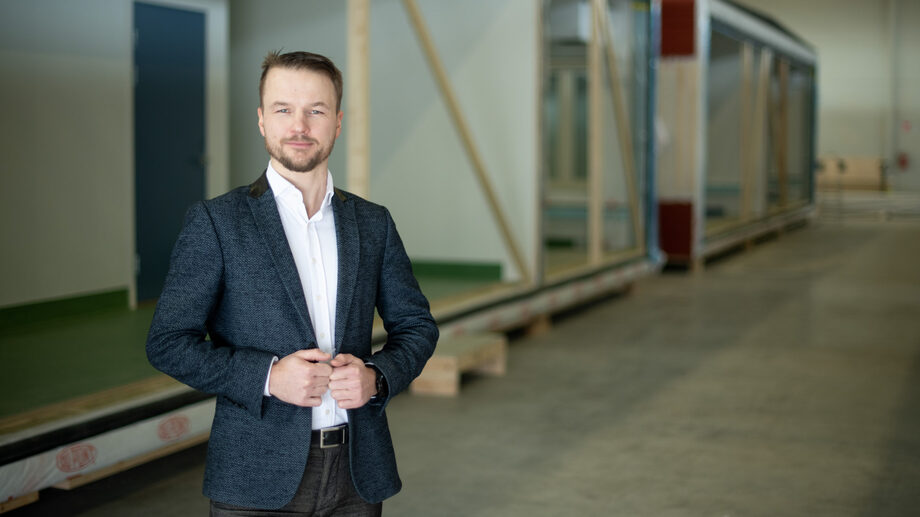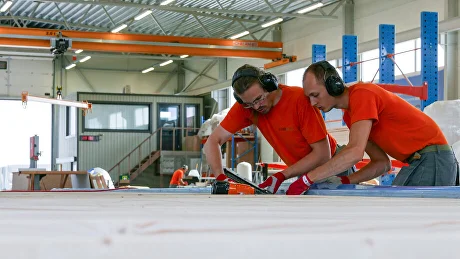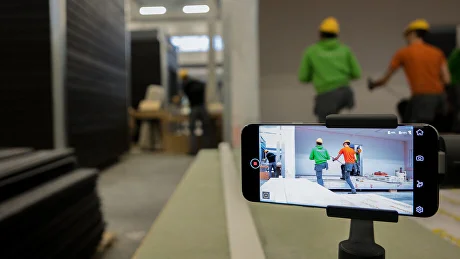Digitization has been on the agenda of Timbeco Woodhouse, Estonia’s leading manufacturer of wooden houses, for almost five years, during which the team has experienced both success and defeat. Today, Timbeco aims to become the leading digitizer in the wooden house industry with Eziil for production software partner.
How it all began
As a successful manufacturer of wooden houses, Timbeco has experienced rapid growth. At one point, however, constant major developments lead a manufacturing company to take a step back in order to regain control of the production. The key broad issue that Timbeco started to address with digitization was the integration of different systems in different departments that were not interconnected.
At one point, however, constant major developments lead a manufacturing company to take a step back in order to regain control of the production.
The data was fragmented to the point that different units and symbols were used throughout the company to measure work and calculate material. Inventory, purchase and warehouse goods movement records were kept in separate Excel files and purchase orders were placed by e-mail. The same data had to be entered several times, because it did not move automatically from one system to another. Therefore, no real-time budget monitoring was available.
Due to inefficiencies in data collection, the company lacked the know-how to effectively analyze the data. According to Timbeco’s CEO Siim Leisalu, the main point of digitization is to create digital systems for collecting the right data to be used in business development.

“The success of a business lies in data and without real-time data, you can’t make the right decisions,” says Siim Leisalu, the CEO of Timbeco Woodhouse.
“The success of a business lies in data and without real-time data you can’t make the right decisions. At the moment, we are still in the phase of measuring the actual results in retrospect to conclude whether we stayed in the budget or not. However, once we get the production module and the time reporting to work through Eziil’s software, we will be able to analyse, reschedule and improve processes in real time – on a daily basis and with hourly accuracy,” he says, recalling a time only a few years ago when invoices were still issued on paper and signed by hand.
In the long run, the aim is to digitize all the activities of the company, which is why the entire chain of activities was initially mapped. Digitization was first taken up in production department with the greatest costs, where the most data is generated, and where measuring and monitoring is needed the most. However, production is closely linked to warehouse inventory, finance and personnel. The search began for a solution to integrate production, HR and financial software.
Finding the right solution
Timbeco’s digitization steering team agrees that choosing the right core software can be difficult, but instinct plays a big role in the process. According to Margus Tamme, Timbeco’s production manager, there are many providers of production tracking software on the market today and the production structure defines the usability of a program. Before reaching Eziil, Timbeco tried other production software – including foreign ones – but with Eziil, according to Tamme, it became clear that this was exactly what they needed.

Timbeco’s IT project manager Karl Kerdt appreciated the strong will and growth potential of the Eziil team, and immediately developed trust in them. “We plan to multiply our production volumes in the next 5 years and we felt that Eziil is the one who can help us with that,” he says.
Timbeco’s IT project manager Karl Kerdt appreciated the strong will and growth potential of the Eziil team, and immediately developed trust in them. “We plan to multiply our production volumes in the next 5 years and we felt that Eziil is the one who can help us with that,” he says.
Eziil promised to create integrations with other software already in use in the company, which became the main point of decision. “A manufacturing company should not change its processes to match the software. It should be the other way around – the software should adapt to the company’s needs. That’s why we were not keen on using one giant ERP. We wanted specific software for each specific activity, and the systems integrated with each other,” explains Kerdt.
According to Leisalu, he preferred the software’s modern feel. The foreseen time schedule and promised results balanced well with the comprehensive budget. A thorough implementation plan also played an important role in deciding. Agreeing on a three-year goal with Eziil provided assurance that there was a shared vision of a reasonable level of functionality for the number of software users. According to Leisalu, Eziil’s flexibility and exceptional understanding of its client’s business played an important role in shaping the agreement.
At the heart of continuous development
Four months after the first contact with Eziil, the implementation of the foreseen changes began. Due to earlier negative experience with production software, there was some scepticism among the team towards the new developments. According to Leisalu, at that point, the most difficult part was to show people the added value that the digitalization of production would provide – how the money, time and energy put into the process would justify it. The IT project manager was expected to have a clear plan on how to proceed with the introduction of Eziil’s software. But according to Kerdt, it was more complicated than that.
“Making warehouse entries became 50% more efficient. Before, the entries were done by two people, but now the workload is reduced to one person. In addition, everyone now has an overview of the state of the stock balance.”
“We can plan our digitization activities with a 3-month accuracy, but already during the planning phase the plan might change and therefore most of the time we feel like we are behind the schedule. While we are dealing with major developments, additional needs arise, or it might happen that instead of one major development, three smaller ones should be tackled first. The process is very agile,” explains Kerdt. He recalls his job interview a year earlier, where he was explained that with each success he would have to overcome 20 herds. And this has proven to be true. However, the challenge has paid off, allowing him to be at the heart of continuous development.
Today, Timbeco’s warehouse inventory processes and purchase orders go through Eziil. According to Tamme, the initial results have already had a reducing effect on his workload and some of the processes have become much more convenient. “Making warehouse entries became 50% more efficient. Before, the entries were done by two people, but now the workload is reduced to one person. In addition, everyone now has an overview of the state of the stock balance,” he explains.
In the next quarter, all Timbeco’s production staff will start using the Eziil’s work time reporting module. The information generated through Eziil’s software will move through the accounting software to the budget management software. It provides an indispensable overview for the project managers, who will be able to track in real time whether a project stays in budget. Although the company uses a number of different software – for example, for sales, budget management and design – Eziil connects with all of them and will always remain the core software, as it collects the main production data.
Not one step back
Timbeco’s management team has set a long-term growth strategy that encourages Kerdt to vigorously promote developments in the company. According to him, digitization is like the city of Tallinn, which will never be completed. Existing IT solutions will inevitably become obsolete over time and newer and more innovative solutions will emerge on the market. This creates a situation where the analysis of older digital solutions and the replacement of non-functioning systems have to be dealt with on an ongoing basis.

Timbeco’s overall goal is to move to 5D building information model (BIM), where the entire information chain is uninterrupted, from the first contact of sales to the end of the warranty period. To do this, all software activities must support the entire enterprise value chain, and the entire information flow must move forward in an increasing schedule. The chain automatically passes on the necessary input to the next work section, and each department can effectively add value to what has already been done.
Kerdt gives an example of a classic saw chain graph – growing and falling alternately – that represents the value chain of a non-digitized manufacturing company, where, for example, information on a sales or budgeting document must first be entered into a new software when it arrives at the design department. Leisalu draws a parallel with the roller coaster: in order to get two steps forward, you must first go half a step back.
Positive long-term effects
Timbeco has spent on average 1.5% of their total turnover on digitization. This includes production software and design, the latter requiring much higher costs to digitize. According to Kerdt, Eziil has stood out with its customer-friendly attitude and transparency, always looking far ahead in its development plan and reconciling the client’s wishes, enabling clients to control costs. Although the initial investment is constantly growing, the efficiency is also increasing.
Timbeco has spent on average 1.5% of their total turnover on digitization.
Although it is too early to draw fundamental conclusions about the real efficiency gains, Kerdt sees a long-term positive effect on the results. The company’s overhead costs will decrease and the added value of production will increase due to smaller paper economy and greater ability to plan more accurately.
According to Tamme, the immediate goals regarding the transparency of warehouse inventory and purchasing processes have already been met, and the integration of reclamations, quality control and work time reporting into a single system will further improve the company’s results. With the introduction of the production module, the aim is to increase the amount of project outcome data by 30%.
Digitization has long been set as Timbeco’s strategic direction and a priority at the top management level. The appointment of an IT project manager to lead the digitization process has proved to be an important success factor, since keeping pace with IT developments and ensuring the achievement of results could not have been effectively done as a side task. According to Leisalu, digitization should be the driving goal for businesses. Even during the COVID-19 pandemic, Timbeco greatly benefited from its digital systems. The transition to teleworking went smoothly and during the critical time, the audit of the ISO standard was completed. The company also kept export sales and project management running successfully.

Timbeco’s IT project manager Karl Kerdt appreciated the strong will and growth potential of the Eziil team, and immediately developed trust in them. “We plan to multiply our production volumes in the next 5 years and we felt that Eziil is the one who can help us with that,” he says.